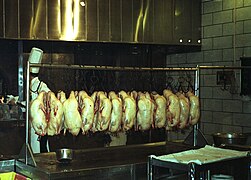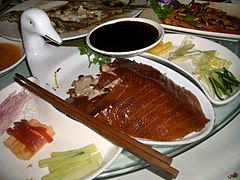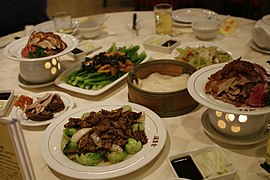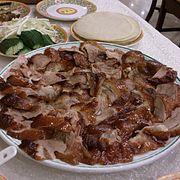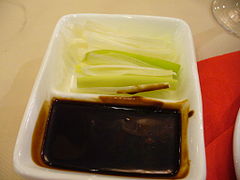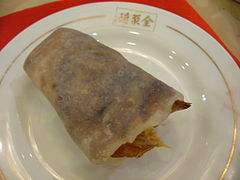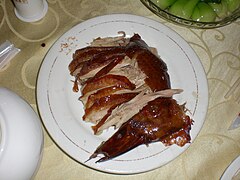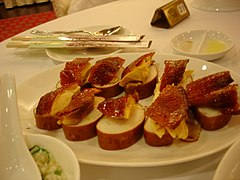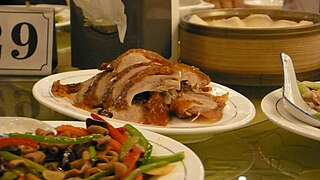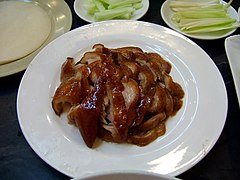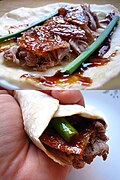Peking duck
| Peking duck | |||||||||||||||||||||||||
|---|---|---|---|---|---|---|---|---|---|---|---|---|---|---|---|---|---|---|---|---|---|---|---|---|---|
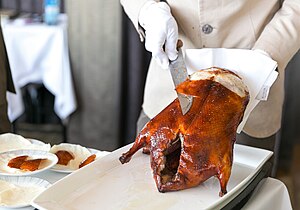 Peking duck carved for show | |||||||||||||||||||||||||
| Traditional Chinese | 北京烤鴨 | ||||||||||||||||||||||||
| Simplified Chinese | 北京烤鸭 | ||||||||||||||||||||||||
| Literal meaning | Beijing roast duck | ||||||||||||||||||||||||
| |||||||||||||||||||||||||
Peking duck is a dish from Beijing[a] that has been prepared since the Imperial era. The meat is characterized by its thin, crispy skin, with authentic versions of the dish serving mostly the skin and little meat, sliced in front of the diners by the cook. Ducks bred especially for the dish are slaughtered after 65 days and seasoned before being roasted in a closed or hung oven. The meat is often eaten with spring onion, cucumber, and sweet bean sauce, with pancakes rolled around the fillings. Sometimes pickled radish is also inside. Crispy aromatic duck is a similar dish to Peking duck and is popular in the United Kingdom.
History
[edit]
Duck has been roasted in China since the Southern and Northern dynasties.[1] A variation of roast duck was prepared for the emperor of China in the Yuan dynasty. The dish, originally named "shāo yāzi" (燒鴨子), was mentioned in the Complete Recipes for Dishes and Beverages (飲膳正要) manual in 1330 by Hu Sihui (忽思慧), an inspector of the imperial kitchen.[2][3] The Peking roast duck that came to be associated with the term was fully developed during the later Ming dynasty,[1][4][5] and by then, Peking duck was one of the main dishes on imperial court menus.[6] The first restaurant specialising in Peking duck, Bianyifang, was established in the Xianyukou, close to Qianmen of Beijing in 1416.[7]
By the Qianlong period (1736–1796) of the Qing dynasty, the popularity of Peking duck spread to the upper classes, inspiring some poets and scholars who enjoyed the dish. For instance, one verse of Dūmén zhúzhīcí, a Beijing local poem, was "Fill your plates with roast duck and suckling pig".[8] [9]
In 1864, the Quanjude (全聚德) restaurant was established in Beijing. Yang Quanren (楊全仁), the founder of Quanjude, developed the hung oven to roast ducks.[citation needed]
By the mid-20th century, Peking duck had become a national symbol of China, favored by tourists and diplomats alike. For example, Henry Kissinger, the secretary of state of the United States, met Premier Zhou Enlai in the Great Hall of the People on 10 July 1971, during his first (secret) visit to China. After a round of inconclusive talks in the morning, the delegation was served Peking duck for lunch, which became Kissinger's favourite. The Americans and Chinese issued a joint statement the following day, inviting President Richard Nixon to visit China in 1972. Following Zhou's death in 1976, Kissinger paid another visit to Beijing to savor Peking duck.[10][11] Peking duck, at the Quanjude in particular, has also been a favorite dish for various political leaders ranging from Cuban Fidel Castro to former German chancellor Helmut Kohl.[12][13]
Two notable restaurants in Beijing which serve this dish are Quanjude and Bianyifang, both centuries-old establishments which have become household names, each with their own style: Quanjude is known for using the hung oven roasting method, while Bianyifang uses the oldest technique of closed oven roasting.[14][15]
Preparation
[edit]Raising the duck
[edit]The ducks used to prepare Peking duck originated in Nanjing. They were large, had black feathers, and lived in the canals that linked the city to major waterways.
With the relocation of the Chinese capital to Beijing, supply barge traffic increased in that area. Often these barges spilled water into side-canals, providing a habitat for the ducks. By the time of adoption of five-spice powder, a new breed of duck had been domesticated by Chinese farmers.[16] Nowadays, Peking duck is prepared from the American Pekin[failed verification] duck (Anas platyrhynchos domestica).[17]
Newborn ducks are raised in a free range environment for the first 45 days of their lives, and force fed 4 times a day for the next 15–20 days, resulting in ducks that weigh 5–7 kg (11–15 lbs).[18] The force feeding of the ducks led to an alternate name for the animal, "Peking stuffed duck" (simplified Chinese: 北京填鸭; traditional Chinese: 北京填鴨; pinyin: běijīng tián yā).[19]
Cooking the duck
[edit]
Fattened ducks are killed, plucked, eviscerated and rinsed thoroughly with water. Air is pumped under the skin through the neck cavity to separate the skin from the fat.[20] The duck is then blanched in boiling hot water for two to three minutes before it is hung up to dry. This tightens the skin.[21] While it is hung, the duck is glazed with a layer of syrup with honey, and the duck's inside is rinsed once more with water.[22][23] A second layer of glaze/marinade of soy sauce, five-spice powder, and more maltose is then applied inside and out, and the duck is left to stand for 24 hours in a cool, dry place (or a refrigerator).[24] It is then roasted in an oven until the skin turns shiny brown.[25]
Besides two traditional methods to prepare Peking duck, recipes have been compiled by chefs all around the world to produce the dish at home.[20][21]
Closed-oven style
[edit]Peking duck is traditionally roasted in a closed oven (Chinese: 焖炉). Bianyifang, a restaurant in Beijing, China, is famous for keeping this tradition. The closed oven is built of brick and fitted with metal griddles (Chinese: 箅子; pinyin: bì zi). The oven is preheated by burning Gaoliang sorghum straw (Chinese: 秫秸; pinyin: shú jiē) at the base. The duck is placed in the oven immediately after the fire burns out, allowing the meat to be slowly cooked through the convection of heat within the oven.[citation needed] Controlling the fuel and the temperature is the main skill. In closed-oven style, duck meat is combined well with the fat under the skin, and therefore is juicy and tender.[citation needed]
Open-oven style
[edit]The open oven (Chinese: 挂炉; lit. 'hung oven') was developed in the imperial kitchens during the Qing dynasty and adopted by the Quanjude restaurant chain. It is designed to roast up to 20 ducks at the same time with an open fire fueled by hardwood from peach or pear trees.[24] The ducks are hung on hooks above the fire and roasted at a temperature of 270 °C (518 °F) for 30–40 minutes. While the ducks are roasting, the chef may use a pole to dangle each duck closer to the fire for 30-second intervals.[24] In open-oven style, the fat is usually melted during the cooking process, so the skin is crispy.[citation needed]
Serving
[edit]

Peking duck is traditionally carved in front of the guests and served in three stages. First, slices of duck skin are served with sugar and sweet bean sauce as a dip. Duck skin is best enjoyed hot and crisp to the bite. The meat is then served with steamed pancakes (simplified Chinese: 春饼; traditional Chinese: 春餅; pinyin: chūn bǐng) and an assortment of vegetable dishes, typically julienned cucumber and spring onion. Traditionally, diners dip slices of duck into the condiments and wrap into the pancake with cucumber and any other ingredients. The wrap is then eaten by hand or with chopsticks. The carved duck (鸭架) – the remainder of the roast duck, with choice cuts removed – can be cooked in three ways. The traditional way is in a broth with ingredients such as Chinese cabbage and soft tofu. The carved duck can also be chopped and stir-fried in sweet bean sauce, or rapidly sautéed and served with salt and pepper (椒鹽). Otherwise, the carved duck is packed to be taken home by the customers.[26][27][28]
Reheating
[edit]Whole Peking ducks can be ordered as takeaway. The ducks can be reheated at home with an oven or stove. When an oven is used, the duck is heated at a temperature of 150 °C (302 °F) for 20 minutes, and then at 160 °C (320 °F) for another 10 minutes. The stove method involves submerging the duck in boiling water before placing it on a griddle 70 cm (28 in) above the cooking fire. The water is replaced every 3–4 minutes until the duck is piping hot. To reheat the Peking duck with oil, the duck is sliced into thin pieces and placed in a strainer held over a wok of hot oil. The duck is then rinsed several times with the oil.[28]
Notable restaurants
[edit]A number of restaurants in Beijing specialise in Peking duck. Examples include Quanjude, Bianyifang, Changan Yihao (長安一號), Dayali, Beijing Xiaowangfu (北京小王府) and Dadong Kaoyadian (大董烤鴨店).[29] Some restaurants, in particular Quanjude and Bianyifang, have long histories of serving high quality duck that they are now household names, or Lao zihao (老字号), literally "old brand name".[30] In addition, Quanjude has received worldwide recognition, having been named a China Renowned Trademark in 1999.[31]
Duck Chang's Restaurant, established in 1975 in Virginia, United States, was the first Chinese restaurant to prepare and serve Peking duck without a 24-hour advanced notice.[32] In 2018, the James Beard Foundation awarded Sun Wah BBQ in Chicago, Illinois, with their America's Classics award, specifically citing Sun Wah's three-course "Beijing Duck Feast" in their announcement of the award.[33]
Crispy aromatic duck
[edit]Crispy aromatic duck (香酥鴨 xiāng sū yā) is a similar dish to Peking duck. It is popular in the United Kingdom,[34] where it was created in the latter half of the twentieth century.[35]
The duck is first marinated with spices, then steamed until tender, and finally deep fried until crispy.[36] The meat has less fat and is drier and crispier compared to that of Peking duck.[37]
In Germany, some Asian fusion restaurants also serve crispy aromatic duck (Knusprige Ente), sometimes also labeled as Peking duck (Peking-Ente, also Pekingente). The duck is marinated with spices and deep-fried, served together with stir-fried vegetables (Wokgemüse) over fried noodles or with rice.
How to taste
The traditional way of eating is just to have the roasted duck carved into slices by the waiter on the spot, separate the duck skin and duck meat, and dip a little duck skin into each slice. Diners usually wrap slices of duck meat in pancakes, and add sweet bean sauce, green onions, cucumber strips and other ingredients to make it a unified meal. This combination has rich textures, crispy skin, fresh and tender meat, and gorgeous seasonings, making it endlessly memorable.
Cultural symbol
[edit]Peking duck is a symbol of gourmet food and one of the representatives of Chinese food culture.[38] Buying Peking duck has become one of the essential experiences for many foreign politicians and tourists not only when visiting Beijing. Time-honored roast duck restaurants such as Quanjude and Bianyifang have become the inheritors of this gourmet culture.
After a hundred years of inheritance and innovation, Beijing roast duck has become more than just a dish. It carries the memory of history and represents China’s rich food culture.[39][40]
Gallery
[edit]See also
[edit]Notes
[edit]- ^ Peking Duck, locally more commonly referred to as Beijing Duck or Beijing Roast Duck as the Chinese capital city was known as its postal Yue Chinese romanisation Peking before the Pinyin romanisation system was widely adopted in the 1980s. Chinatown Connection 2005. Retrieved 18 May 2010.
References
[edit]- ^ a b "品味北京五大百年名吃 (500-year-old delicacies of Beijing)". Xingchen Food Network (in Chinese). China News Information Centre. 22 September 2006. Retrieved 10 September 2007.
- ^ "北京特產 (Specialties of Beijing)" (in Chinese). Xinhua. 8 April 2004. Archived from the original on 13 November 2007. Retrieved 10 September 2007.
- ^ "Slicing through the secrets of Peking Duck". Adelaide Review. 2005. Archived from the original on 22 August 2006. Retrieved 10 September 2007.
- ^ "Peking duck". Encyclopædia Britannica.
- ^ "A Cultural Classic: Peking Duck". Globe Trekker. Archived from the original on 2012-05-17. Retrieved 2008-11-12.
- ^ "History of the Peking Duck". SilkRoad. Archived from the original on 25 August 2007. Retrieved 10 September 2007.
- ^ Zhang, Jackie (29 June 2007). "New locations for Qianmen's traditional restaurants". Beijing Today. Archived from the original on 21 December 2008. Retrieved 10 September 2007.
- ^ "Peking Duck Information". China Internet Information Center. Retrieved 10 September 2007.
- ^ "......两绍三烧要满壶,挂炉鸭子与烧猪......"——杨米人《都门竹枝词》"从明朝开始,烤鸭的价格倒没怎么涨". Read001. Retrieved 26 November 2017.
- ^ "Premier Zhou's roast duck diplomacy (周总理的烤鸭外交)" (in Chinese). Quanjude. Archived from the original on 13 October 2007. Retrieved 14 September 2007.
- ^ "Interview with Ambassador Winston Lord". George Washington University. Retrieved 14 September 2007.
- ^ "Beijing gets its ducks in a row for heavenly roast". Reuters. 5 August 2008.
- ^ "Torch finally heads for Beijing". London. [dead link]
- ^ "Now the owners of the 148-year-old restaurant plan to diversify into a multi-brand catering service provider that taps both high-end and mass markets.""Roast duck restaurant Quanjude looks at multi-brand expansion". South China Morning Post. 4 February 2013. Retrieved 23 April 2014.
- ^ "Bianyifang is a brand name established in 1416. Its closed-oven Peking roast duck is famous." "Bianyifang serves up new restaurants". China Daily. 26 June 2013. Retrieved 23 April 2014.
- ^ Davidson, Alan (2010). Oxford Companion to Food. Oxford: Oxford University Press. p. 593.
- ^ Li, Ping-Wei; Liu, Wei; Li, Gen-Pei; Zhu, Rong-Huan; Wang, Da-Cheng (2001). "Over-expression, purification, crystallization, and preliminary X-ray diffraction analysis of CuZn superoxide dismutase from Peking duck". Acta Crystallographica. 57 (11): 1646–1649. doi:10.1107/S0907444901011106. PMID 11679732.
- ^ "The origins of Chinese Roast Duck (访古探幽:中国烤鸭的由来)" (in Chinese). Sing Tao. 31 December 2005. Retrieved 12 September 2007.
- ^ "Recipe for Peking Stuffed Duck" (in Chinese). 美食菜系. Archived from the original on 1 February 2009. Retrieved 12 September 2007.
- ^ a b Bryant, Simon. "Peking Duck 101". ABC Adelaide. Archived from the original on 6 December 2007. Retrieved 12 September 2007.
- ^ a b "Preparing a Pekin Duck". Notes from a Devon Kitchen. 2 March 1998. Retrieved 12 September 2007.
- ^ Zheng, Huoqing; Cao, Lianfei; Huang, Shaokang; Neumann, Peter; Hu, Fuliang (2018), Chantawannakul, Panuwan; Williams, Geoffrey; Neumann, Peter (eds.), "Current Status of the Beekeeping Industry in China", Asian Beekeeping in the 21st Century, Singapore: Springer Singapore, pp. 129–158, doi:10.1007/978-981-10-8222-1_6, ISBN 978-981-10-8221-4, retrieved 2023-02-04
- ^ Dunlop, Fuchsia (8 July 2021). "Peking duck: the complex history of a Chinese classic". National Geographic. Retrieved 4 February 2023.
- ^ a b c "Quanjude Roast Duck". Golden Lawyer. Archived from the original on 31 May 2007. Retrieved 14 September 2007.
- ^ "Beijing cuisine: Peking Duck Recipe (北京菜: 北京烤鴨)" (in Chinese). Social Work Hong Kong. 1 June 1970. Archived from the original on 10 June 2007. Retrieved 12 September 2007.
- ^ "The Evolution of Peking Duck". CBS. 24 September 2006. Retrieved 17 September 2007.
- ^ Liang, Shih-Chiu. "Roast duck" (烧鸭). in Jiang H. (ed.) Liang Shiqiu's Selected Proses (2000). Hangzhou:Zhejiang Literary Press. ISBN 7-5339-0562-8
- ^ a b "How to reheat a takeaway Peking Duck(外卖烤鸭如何加热)". Hainan News Network. Xinhua. 27 April 2005. Archived from the original on 12 November 2007. Retrieved 18 September 2007.
- ^ "Top 5 places to dine on Peking Duck (吃北京烤鸭最HIGH的5大去处)". Northern Net (in Chinese). Xinhua. 25 August 2004. Archived from the original on 24 October 2007. Retrieved 4 October 2007.
- ^ Chen, Nan (14 April 2006). "Old Name, New Experience". Beijing This Month. Archived from the original on 25 December 2007. Retrieved 4 October 2007.
- ^ "Quanjude puts duck on the stock-market menu". Shanghai Daily. Sina. 27 September 2007. Retrieved 3 October 2007.
- ^ "Peking Duck Restaurant". pekingduck.com. Retrieved 5 September 2015.
- ^ "Sun Wah BBQ to receive coveted 2018 James Beard America's Classics award". Chicago Tribune. 18 January 2018. Retrieved 24 July 2020.
- ^ "Savour the success from aromatic". Cherry Valley. Archived from the original on 2 February 2009. Retrieved 5 October 2007.
- ^ "Crispy Aromatic Duck And Other British Inventions". DimSum. Archived from the original on 29 September 2011. Retrieved 1 October 2011.
- ^ Hom, Ken. "Recipe for crispy aromatic duck". BBC. Archived from the original on 7 September 2007. Retrieved 5 October 2007.
- ^ "Peking Duck". Beijing Made Easy. Archived from the original on 22 February 2014. Retrieved 5 October 2007.
- ^ "Why is Duck so Special to Chinese Cuisines?". Chowman. Retrieved 20 September 2024.
- ^ "Knusprige Ente mit Nudeln". Chefkoch. Retrieved 26 November 2017.
- ^ "Pekingente mit Ponzu-Sauce, Sesam-Wokgemüse und Reisküchlein". Netto. Archived from the original on 1 December 2017. Retrieved 26 November 2017.

